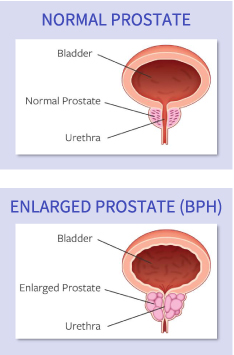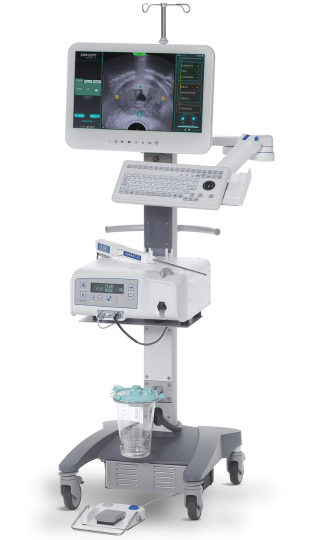Aquablation Therapy Surgical Treatment for BPH (Enlarged Prostate)

Aquablation therapy is used to treat benign prostatic hyperplasia (BPH), also known as an enlarged prostate. This minimally invasive robotic procedure can result in standardized outcomes for long-term BPH relief. It is available for patients suffering from lower urinary tract symptoms due to BPH.
What is an enlarged prostate?
 Most men will develop an enlarged prostate if they live long enough. The prostate is a gland that surrounds the urethra, which is the tube that carries urine out of the body. When the prostate grows larger, it puts pressure on the urethra, which makes it harder for urine to pass through.
Most men will develop an enlarged prostate if they live long enough. The prostate is a gland that surrounds the urethra, which is the tube that carries urine out of the body. When the prostate grows larger, it puts pressure on the urethra, which makes it harder for urine to pass through.
Symptoms of BPH include the inability to urinate, dribbling at the end of urinating, not emptying your bladder fully, the need to urinate frequently, and a sudden and strong urge to urinate.
BPH is not cancer and it does not increase your risk of getting prostate cancer.
How Does Aquablation Therapy Work?
 Aquablation therapy removes the extra prostate tissue that is causing the prostate to become larger and put pressure on the urethra. No incisions are made during the procedure. Rather, the surgeon reaches the prostate through the urethra. A high-powered heat-free waterjet is then used to remove excess prostate tissue that may be causing BPH.
Aquablation therapy removes the extra prostate tissue that is causing the prostate to become larger and put pressure on the urethra. No incisions are made during the procedure. Rather, the surgeon reaches the prostate through the urethra. A high-powered heat-free waterjet is then used to remove excess prostate tissue that may be causing BPH.
Aquablation therapy integrates ultrasound imaging with a camera (cystoscope). This enables your surgeon to see the entire prostate in real time, which helps them identify which parts of your prostate should be removed and which parts to not touch. Once this surgical map is completed, a robotically-controlled, heat-free waterjet removes the prostate tissue that was outlined on the map. This robotic technology helps minimize human error in removing prostate tissue and helps ensure the prostate tissue is removed precisely, consistently and predictably.
Aquablation therapy is performed in a hospital and is done under anesthesia. The procedure usually takes less than an hour and normally involves an overnight stay.
Find a surgeon
If you need a referral to a surgeon at Palmdale Regional Medical Center, call our free physician referral service at 800-851-9780 or search for a physician online.
Benefits of Aquablation Therapy
There are several benefits of undergoing Aquablation therapy:
Minimally invasive
Aquablation therapy is a minimally invasive procedure, which means no incisions are made. This reduces the risk of infection and complications, reduces pain, results in less bleeding and helps speed up recovery time. The heat-free waterjet used in the procedure is precise and targeted, minimizing damage to surrounding tissue.
Reduced risk of blood clots
Blood clots often form in the bladder after traditional BPH surgery. These clots can lead to pain and difficulty urinating, and they can even require additional surgery to remove. The risk of blood clots is significantly reduced with Aquablation therapy. The heat-free waterjet used in the procedure flushes out any debris or blood clots, reducing the chances of post-surgery complications.
Shorter hospital stay
Aquablation surgery typically requires a shorter hospital stay than traditional BPH surgery because it's a minimally invasive procedure. Most patients are able to go home the same day or the next day. This not only reduces the cost of hospitalization but also allows patients to recover in the comfort of their own home.
Recovery from Aquablation Surgery
You will have a catheter when you wake up after surgery. This will remain until you are able to pee on your own and empty your bladder at the time of discharge. If you are unable to do that, we may send you home with a catheter for a few days.
Patients typically stay overnight in the hospital. Once you are home, you may experience mild burning during urination for a couple weeks. This can be managed with mild pain medication.
Is Aquablation Therapy Right For You?
You should always talk to your physician about whether you are a candidate for any procedure. For Aquablation therapy, you may need to meet certain age or physical requirements to be able to withstand minor surgery.
Patients experiencing urinary urgency and frequency, slower stream, waking up frequently at night to urinate, and the sensation of incomplete emptying of the bladder are candidates for Aquablation therapy. It is not recommended for men who have had previous prostate surgery, have certain medical conditions such as severe bleeding disorders or severe heart disease, or have active urinary tract infections.
Individual results may vary. There are risks associated with any surgical procedure. Talk with your doctor about these risks to find out if minimally invasive or robotic surgery are right for you.
